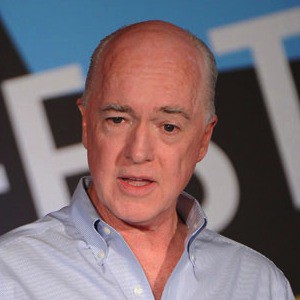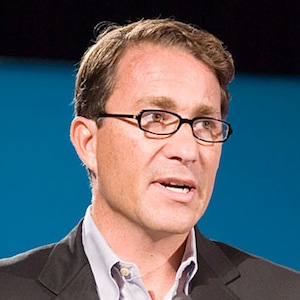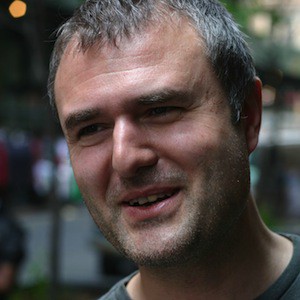Peter Hamby: Go back to The Post days. Was there a crystallizing moment for you guys when you realized that the digital space had a real future for both your careers and news in general? Was there some founding moment?
Jim VandeHei: Harris?
John Harris: No, there wasn’t a light switch that went off. Anytime, starting from the late ’90s onward, people became more and more aware of how the web was going to influence the future of all journalists. I became increasingly struck, over in The Post, that how much of impact that our stories had been moved into a digital space, but how much of our professional work lives, our daily routines, our mental habits, were still grounded on the once every day the paper comes out rhythm. I grew, over time, increasingly distressed by that, because it seemed to me a real disconnect between where our audience was and where our effort was. But that wasn’t a light switch moment, that was something that happened over time.
Jim: Yeah, I remember back then The Post was actually two physically different companies. One was a digital company on this side of the river, the other was the newspaper company in DC. Nobody was going from the newspaper over to digital. This is mid 2006, when almost nobody’s going online, and for us it was never like, “Oh my god, The Post is sinking, we’ve got to get out of here. We’ve got some brilliant prophecy, that we know what the future is,” it was more a conversation about, “We’ve got this really cool idea, we’re looking at what’s happening on cable, what’s happening on the Internet, and the opportunity where journalists who have their own brand can really make a mark.”
That was really the evolution of Politico, was saying, “What if we just got six or eight of us together, started a company, we know we’re going to break news, we know we’ll get on TV, we know we can get people to pay attention. Let’s see if that could actually be the germ of a company.”
Peter: But did you have an idea that you took to your superiors at The Post?
Jim: It evolved from that.
Peter: So what was that idea?
Jim: It was essentially an evolution of what we’ve just described. It was that we had an idea that, once we went and talked to people who were much smarter than we were, and had money that we certainly didn’t have any access to, about the economics of this. Could you create a website that was built around just being really interesting, breaking news, driving a conversation, day to day? Could you build a business model around that? I think with each conversation we had, many of them with friends of John’s from over the years, everyone was like, “Yes, yes, yes, yes.”
John: What we believed then, and still believe, is that the digital space rewards niche publications that can really organize themselves editorially, organize themselves in terms of a business model around a single subject, or at least a single set of closely related subjects. That’s really hard for the general interest news organization. We wanted to be a specialized site, with reports reflecting that specialization. In other words not generals, but people who really knew politics, and knew government well. We talked about building that kind of space within The Post as kind of a site within a site, as one idea. Simultaneously with that, we had an offer to try to build that site from scratch.
Peter: From outside?
John: From outside.
Peter: What happened when you talked to the folks at The Post, when you took this argument to them, or the idea? What was their reaction? What were the conversations like?
John: There were a lot of people at The Post at that time, and I think that’s still true of the people over at The Post, who are thinking very hard and very seriously, conscientiously, about these questions. They were intrigued and enthusiastic to try different ideas. There was certainly a possibility that we would have stayed at The Post and tried to go with this site within a site strategy. In the end, it ended up being more attractive, and I think more successful than it could have been by starting from scratch rather than trying to build within an existing brand and an existing institution.
Jim: An existing institution would have strangled the idea. The reason I think it worked is we were able to move so quickly and not have any of the baggage of being a legacy institution. Nothing against The Post. It was just a big newspaper that was getting the bulk of its money from the newspaper. The idea that suddenly they were going to give us the freedom to really build something in isolation, I think they wanted to do that, and I think in retrospect it would have been really hard for them to do that.
Peter: You used the word baggage. What else do you see as baggage from a legacy?
Jim: It’s what’s killing newspapers. The baggage that I described is just the fact that they went through years and years and years, a generation of profitability, and they were newspapers. They were used to putting on a physical newspaper, and that creates rhythms, that creates demands, that creates a certain type of reporter. Obviously when you say, “You’ve got to change that.” You’ve got to move quicker, you’ve got to be on digital, you’ve got to have people who maybe are mediocre reporters or they’re solid reporters, but they’re not household names, and you suddenly look at a media culture that’s certainly rewarding people that were doing distinctive work or were household names. People that can get on TV, people that can break news, people that can write stories that are going to get clicked around.
That’s a tough transition to make. It’s tough to do from scratch. Just really tough. It’s tough for any big institution to change quickly. It’s the reason reinventing government is hard, it’s the reason that restructuring a corporation is difficult. You get habits ingrained into a company that are very difficult to undo.
Peter: How confident were you that this digital venture would work? Did you have metrics and numbers to back this up or were you just flying blind? [laughs]
John: [laughs] No, we had an intuition and a hunch. It wasn’t just blind hunches. It was hunches based on what we were seeing all around us. It’s not like 2006, early 2007 was so long ago. By that time, there were already plenty of examples that we were seeing of reporters and sites that were outside the traditional establishment of journalism having lots of success, lots of impact, doing lots of creative work. We could see that. The relative position of places like The New York Times, the Wall Street Journal, or the Washington Post, which used to be unchallenged, unchallenged superiority, unchallenged ability to set the agenda, that relative position was rapidly diminishing. Lots of places were competing for attention, for impact, for being the most important story of the day. Abundant evidence.
We took that evidence, and it made us believe that, if we got the right roster of people with the right focus, that they could have impact. That was the intuition or the hunch. But at the time we started, the time Robert Albritton gave us the green light and a budget to go out and try this, it wasn’t in our mind or in his so sharp that we knew exactly how we were going to measure success, exactly what success would looks like in our traffic, or revenue, or anything else.
We had a high degree of confidence that we had a good idea, and we had a fairly high degree of confidence that, if that idea was good, that we were the right people to make it work. But beyond that, we were operating on a hunch.
Peter: Moneywise, how long did it take you to find your sea legs? Were you making money quickly?
John: It’s been a while ago now, but these were long early months, when we were a new brand in Washington and digital revenue market was still pretty young. Those early months were very slow. The ad market is really pretty made up, at least then, I think maybe it’s changed, it was made up of very conservative people, who themselves were products of institutions and products of old habits and old ways of thinking. That first year, 2007, we felt like we were having immediate impact. Almost from day one we were breaking news. We were getting quoted. We were seeing the news product be successful. I think there was a lag time of maybe six months or so before we started to see the revenue come in.
A lot of that early revenue did come in our paper. It was only about a year after that, that we really saw the digital revenue start to come to us in a big way. It seems to me now that the ad market has caught up. They’re no longer so stained. In fact, people are always looking for the new thing, puts a burden on us to keep innovating.
Peter: How much of your revenue is from the subscription product versus the newspaper, versus digital ad revenue?
Jim: If you go back to even three or four years ago, almost all of our money, 80 percent, was coming from the newspaper. Now it’s a much more diversified company. We get more from digital than we get from the newspaper on the advertising side. We’ve added subscriptions, high end subscriptions, not like The New York Times, doing a broad based subscription at this point. We’re just doing high end subscriptions for political insiders and that’s been very successful. If you look at, almost everybody is doing the same thing now. They’re just doing different variants of it. To be a successful media company you have to have, essentially, four or five different revenue streams.
You have to have subscriptions. You have to have print ads. You have to have digital ads. You have to have mobile ads. Almost everyone has events now. You’ve got to hope that the totality of those revenue streams is big enough to fund a profitable company. I think that’s the big test for everyone.
As John was saying earlier, the idea of niche publications, if I were an investor and I was going to place my bet on companies, I’d be placing it on companies that have real focus and real expertise, and therefore command the attention of an important audience every day of the year.
Folks like us, or the Financial Times, or the Wall Street Journal, or AllThingsD, I just think it’s a lot easier to build a business model around that than it is around a traditional newspaper, either a small newspaper or a national newspaper, that is of general interest. Those are the ones that are going to have a tough time.
Peter: Do you think of yourselves as a national brand or distinctly Washington brand?
Jim: We care most about being a Washington brand but undoubtedly we’re a national brand. Our traffic is what, 88 percent now outside of Washington, DC.
John: Some months between 5 and 10 percent coming from abroad.
Peter: How big is the newsroom now compared to when you started?
John: It’s a lot bigger. We started as an organization as a whole with about 60 people, of which probably 40 people were in some capacity or other in the newsroom reporters, web producers, editors. Now we’re a company of 250 plus of which probably about 180 or so are newsroom based.
Peter: During the last presidential race, how many reporters did you have? You were paying to send reporters out on the road and travel the country. A lot of news organizations weren’t. Do you have any idea of how many reporters you sent out or how much money you spent on the election last year?
John: I know how much money we spent. That’s a knowable fact. We had a core group of probably 8 to 10 people owning our coverage and then we had people making different cameo appearances, probably 20 or 30.
Peter: Can you talk about the norms and values of this newsroom compared to The Post? That seems to be your main point of reference. When you’re hiring here, what do you want from a reporter that’s different from what The Post might want, and how does the newsroom operate? There are all sorts of legendary stories about you guys really pushing your reporters very hard and…
Jim: That’s Harris.
Peter: …like to break news.
John: I don’t really consider The Post our main point of reference. It’s one point of reference but it’s not…
Peter: It’s not your competition.
John: …obviously it’s where our experience is. We’re a niche publication that will thrive on its ability to attract people who are singly obsessive about that subject matter, who know it better, who care more about it, who are more energetic in pursuit of the big stories. That’s the definition of a niche publication, is to have people who are singularly focused rather than general interest folks. Our best people have that. Our most ambitious people come in wanting to be that for themselves. Actually we don’t really push people that hard because the reality is that our most successful people here are self motivated.
Jim: I don’t think that they do. I mean most newsrooms probably want. I think we’ve figured out, it took us a long time to figure out what type of personality works here. Like finding people who want to own their beat, who have a unique ability to break news or to write better than other people. That stuff matters and we tend to try to pay a premium if that’s what it takes to have those people working for us. There’s just no market for mediocrity so the pressure is on us to produce really good journalism. Not everybody can produce really good journalism. I think if you had to list the top 20 reporters in town, I’d say we have more than half of them.
I think that’s a pretty good achievement if you think about Congress, politics, and the White House. Those people are that’s gold. We’re trying to tell people stuff they don’t know. We’re trying to inform people and make them smarter.
Peter: Can you talk about the advantages of being a start up, editorially or more financially, does it make you more nimble?
Jim: It does if you don’t screw it up. In the beginning it certainly makes you more nimble because you have no legacy, which could either be you make good decisions and build a culture that works, or you can make a bunch of bad decisions and build it as just a dysfunctional start up as you would have a dysfunctional older institution. I think one of the smartest things that we did is early on, we’re not CEOs, we’re not businessmen, we’re journalists by training, but we went out and we found people in business, ether CEOs or media executives and asked them, “How do you set up a good company? What works? What doesn’t work? What are the things we should be doing?”
By no means I think we had good instincts in retrospect but there’s a lot of stuff that it took us a long time to figure out. How to be good managers. How to be good leaders. What is the appropriate balance of trying to demand the best out of people but not wearing them into the ground?
That process to us has probably been one of the most exciting parts of this job, is just learning, building new muscles that we didn’t have. That’s all we did. We were journalists and then we had to become leaders. That’s just a different world.
Peter: What do you think your most disruptive impacts have been in the media landscape in our current media ecosystem? What’s been your big picture impact do you think? Have you changed the kind of content that people want that other news organizations are not delivering?
John: Yes. I do think that the people who care most about a subject have a demand for immediacy. They have a demand for sophistication. They have a demand for volume. They want to know what’s going on. They don’t have a casual interest in stuff, they have intense interest in this stuff. I think that was the opening that we had, that was a lot of political coverage and a lot of government coverage. There wasn’t a lot of coverage that was giving the kind of intensive focus that we were both in the moment and with a high degree of knowledge and context and sophistication behind that coverage. I think that’s changed the audience’s expectations.
Jim: One of John’s obsessions early on was this idea of getting rid of a lot of the journalistic conventions, the “voice of God.” The truth is we still say it to this day why in the hell is it that there’s such a huge gap between how interesting reporters are, either in email or at a bar, than what they are when you actually read them? I think we have successfully narrowed that. We’ve taken these people who are fascinating minds. We have some of the most curious, intellectual minds around, and I think we get more of it. We force more of that in front of our readers, because readers, they don’t need the “voice of God.” They don’t always need the background. They like to have fun with journalism. They like to be informed. They like to be entertained. They like to be challenged.
I think we’ve been very successful at that. I don’t know that that’s necessarily a disruption, because I don’t know that others are doing that much of it. The disruption John described…if speed was not in this market, we brought speed to it. But now everybody does speed, so that’s not sufficient.
John: It’s not like we were disruptive, but there are people who are disrupting us. Twitter is a great example. They’ve taken some of the role that used to be occupied by blogs and made them less relevant.
Peter: Also, I feel like in the last…like in 2008, you guys broke a ton of news and then you were sort of a go to news breaking site. Then Twitter kind of happened in between and took some of that space, right? [crosstalk 18:48]
Peter: You guys still broke the news…
John: The routine news that you get just by virtue of being there and posting first, basically there is no way to win that competition. Twitter will always be there first. It’s not always the competition that most interests me, I think, is really the one that we focus on, is the publication. There’s no way that Twitter’s going to break the Herman Cain story. Twitter can be fast, but it has a hard time being really smart and I think we can do that.
Peter: Do you view yourselves as competitors with The New York Times and the Washington Post and the Wall Street Journal? Are you waking up every morning trying to beat them on stories?
John: Sure. Them and lots of other people, too. The way the media universe has changed, everybody’s a potential competitor. It might be CNN one moment. It might be Huffington Post one moment. It might be the Washington Post one moment. Yeah, I feel like that. Every day the game is to have the most interesting story on politics or on Washington anywhere. Some days you win that competition, some days you won’t, but we’ll judge ourselves by we win it more often than others. I feel sure that they, in their political coverage, will view us as competitors. We’re going to certainly view them as serious competitors whom we respect.
Peter: That gets to my earlier question about disruption. I talked to Stuart Stevens yesterday for a separate project I’m doing and he was complaining about The New York Times coverage, the cycle. He was saying this in a sort of derisive way, but he was like, they only cover a process and personalities, and they were trying to keep up with Politico, and they were trying to be Politico when they should have been New York Times. I have a hypothesis that a lot of news organizations are now trying to do the peel back the curtain thing and they didn’t used to do that. I think that’s partially due to what you guys have been doing. Do you disagree?
John: Might be. It might be. I think everybody’s trying to…if you were The New York Times 10 years ago, what you wrote, just because you were The New York Times mattered. You set the agenda. That’s not true anymore. If they write a boring story, it’s a boring story that nobody’s going to read or pay attention to. It does up the ante for quality journalism. What breaks through? That’s it. If you can break news, it breaks through. If you can offer a sharp analysis, that breaks through. If you can do an investigative piece that other people don’t have, that breaks through. It’s the companies that produced a lot of news that has now commoditized that have the hardest time adapting.
I think a lot of the big institutions essentially did produce a lot of commoditized journalism that now is irrelevant because everybody has it, and if you’re interested in it, you’re getting it on Twitter or Facebook in tiny little bites and you’re looking for something else. When you talk about disruption, you have to remember that. Disruption’s a baby. We’re only in the beginning of it. If you think about new media, the thing exploded in late 2006, early 2007, we’re just in the early stages of that.
Nobody knows how this plays out. You went through the web disruption, which we just went through. Now you’re going to go through the pay model disruption of who will pay for what, which we don’t know. Times is having some success. Others not so much success in that area.
Then by the time people figure both those out, 50 percent of all consumption of media is going to be done on something this size, which has massive ramifications for how long a story can be. How you present your journalism. That’s going to be a hell of a disruption. Disruptions…it’s not like they’re over. We’re just sifting through to figure out what worked and what didn’t work. It’s constant.
Peter: What are you finding that people are paying for in the politics space?
Jim: Remember, ours is unique in that we’re not The New York Times doing a metered system at this point. What we’re doing is we have set up a series of verticals that are essentially Politicos little mini POLITICOs for different sectors of the economy health care, energy. People in this town will pay for information that’s essential to them doing their job. There’s no doubt. We’ve proven that with our POLITICO Pro and we’re going to continue to expand that because I think we’re very good at producing the type of journalism that this city needs to function. Now that’s much different than the broader based journalism that we’re doing that’s for the country, for the world. That’s different than that.
At some point, we’re going to test, I’m sure, a pay model for all of our content, like everyone else, but we don’t know how that plays out. Just beginning that experiment.
Peter: Have you guys seen any other organizations apply your model in an interesting way or successful way to completely different sectors. Verticals like sports, business, Silicon Valley or whatever.
John: Sure. [crosstalk 23:37]
Peter: …they look to you and they’re like, Oh, those guys are doing something pretty cool.
John: AllThingsD, Business Insider, Foreign Policy.
Jim: ESPN is one of the world’s biggest brands.
John: But we copied them, right? [crosstalk]
Jim: …a bit longer than we did.
Peter: The last thing I want to ask you is video. Last year, you guys implemented a web show during the campaign, which got a lot of insider attention. It got a lot of buzz. I emailed in a couple times.
Jim: I remember that. I might have mentioned you once or twice.
Peter: Yeah, thanks. You’re shooting all kinds of video content here.
Jim: Correct.
Peter: You’ve got a full time professional video staff. Why? Why video online?
John: One, because I think it’s one of the buckets of experimentation and I would say that video, for all of us by the way, is total experimentation right now. Nobody, the best that I can tell, has cracked the code on how you do video outside of being a cable network online where you make money. We all think there’s the potential, because there’s this massive audience for it, if you can do it right. For us, it’s all about experiment, experiment. If it works, it works. If it doesn’t, move on. What works? Those shows work because there is a huge audience online in moments, in big days, a primary, an election, State of the Union.
What we have found, it’s really hard to get a live audience — probably impossible to get a live audience — outside of a big day, so you try to move away on the days where you don’t have a big event to something that is on demand, where you can slice it and dice it. Make sure you’re putting video matching up with stories that are similar to it, because most people are reading something, might be interested in also watching something about it.
I think that’s a place where we put a lot of emphasis on. Or we’ve also started to experiment a lot with just shorter shows. The attention span online, you’re not getting people to sit down for 30 minutes. Period. Five, yeah.
Peter: Are you seeing a lot of engagement with your video content online?
John: We do, but again, it depends. Certainly the shows that we’re doing, we’re seeing that we can start to build an audience for, and certainly video that is topical to the story, you can get a good audience for. The stuff that we’ve certainly struggled with I think everyone’s struggling with is just trying to do a show every day that’s longer than five minutes and think that you’re going to get a loyal audience. That’s a challenge and a lot of people are experimenting with it.















